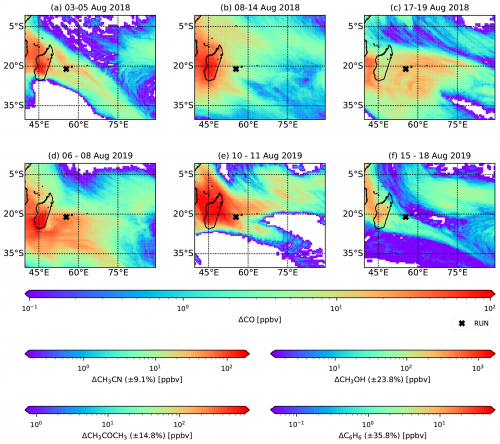In the framework of the OCTAVE project, a near-continuous high time-resolution dataset of VOCs was realised between October 2017 and November 2019 at the high-altitude Maïdo observatory on Réunion Island. This dataset is used to better understand the sources and sinks of VOCs in the tropical marine atmosphere.
Biomass burning plumes reach the remote site
African and Madagascan burning sources can impact the local atmospheric composition at La Réunion. At times, these plumes are visible to the human eye as a brown haze around the island and they are reported in local media:
- Un voile brumeux plane sur La Réunion - Imaz Press Réunion (8 August 2019)
- Incendies en Afrique : les Hauts de La Réunion particulièrement impactés - Imaz Press Réunion (9 August 2019)
Researchers at BIRA-IASB have selected six such events taking place in August 2018 and August 2019 to characterise biomass burning plumes and their impact on the atmosphere over the South-West Indian Ocean.
Identifying gaps in current knowledge
VOC data were combined with routine measurements of carbon monoxide (CO), nitrogen oxides (NOx = NO + NO2), and tropospheric ozone (O3) to look for gaps in current knowledge. We were able to identify two clues on missing sources:
- Recorded concentrations of formic acid were about 5 to 10 times higher compared to what was expected from the literature. This indicates that formic acid is produced inside the biomass burning plumes during transport, but the formation mechanism is yet unknown.
- The Copernicus near-real-time atmospheric composition service (CAMS) underestimates the concentrations of O3, especially in young plumes. This is linked to an underestimation of NOx concentrations, the second key ingredient in O3 formation near the surface, for which the reason is not yet identified.
Transport of biomass burning plumes
Employing atmospheric transport models, we were able to show that African or Madagascan biomass burning plumes are transported at high altitudes in the atmosphere above the South-West Indian Ocean, reaching Maïdo observatory in about 7 to 14 days.
The concentrations of acetonitrile, acetone, benzene and methanol are estimated to increase by a factor of 1.25 to 2 within these biomass burning plumes compared to the otherwise pristine atmosphere over the ocean surface. This shows the potential of using simultaneous measurements over the ocean (using ship-borne instruments) and at the Maïdo observatory to better estimate ocean-atmosphere interactions. This is especially of interest for species such as acetone and methanol for which the role of the ocean is still uncertain.
References
Verreyken, B., Amelynck, C., Brioude, J., Müller, J.-F., Schoon, N., Kumps, N., Colomb, A., Metzger, J.-M., Lee, C.F., Koenig, T.K., Volkamer, R., and Stavrakou, T. (2020). Characterisation of African biomass burning plumes and impacts on the atmospheric composition over the south-west Indian Ocean, Atmospheric Chemistry and Physics, 20(23), 14821-14845. https://doi.org/10.5194/acp-20-14821-2020 


